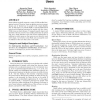593 search results - page 87 / 119 » The Emergence of Visual Object Recognition |
PAMI
2010
13 years 6 months ago
2010
Computer-vision attention processes allocate computational resources to different parts of visual input and can lead to faster object recognition and image analysis. This paper p...
ASSETS
2008
ACM
13 years 9 months ago
2008
ACM
We describe a system for guiding blind and visually impaired wheelchair users along a clear path that uses computer vision to sense the presence of obstacles or other terrain feat...
ASSETS
2010
ACM
13 years 5 months ago
2010
ACM
Smart phones typically support a range of GPS-enabled navigation services. However, most navigation services on smart phones are of limited use to people with visual disabilities....
PUC
2010
13 years 6 months ago
2010
Abstract In the ubiquitous computing environment, people will interact with everyday objects (or computers embedded in them) in ways different from the usual and familiar desktop u...
ICCV
2007
IEEE
14 years 9 months ago
2007
IEEE
Most recent class-level object recognition systems work with visual words, i.e., vector quantized local descriptors. In this paper we examine the feasibility of a dataindependent ...

